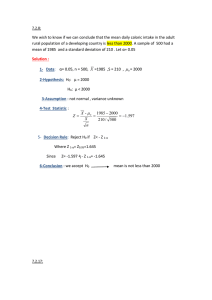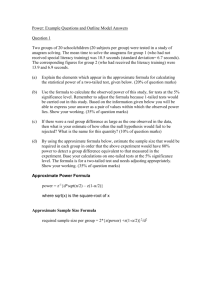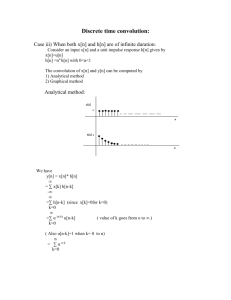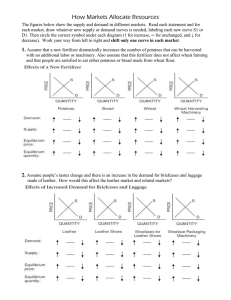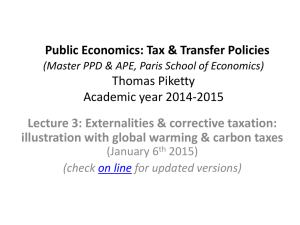Trade Reform and Endogenous Local Preferences Abstract Janne Niemi
advertisement
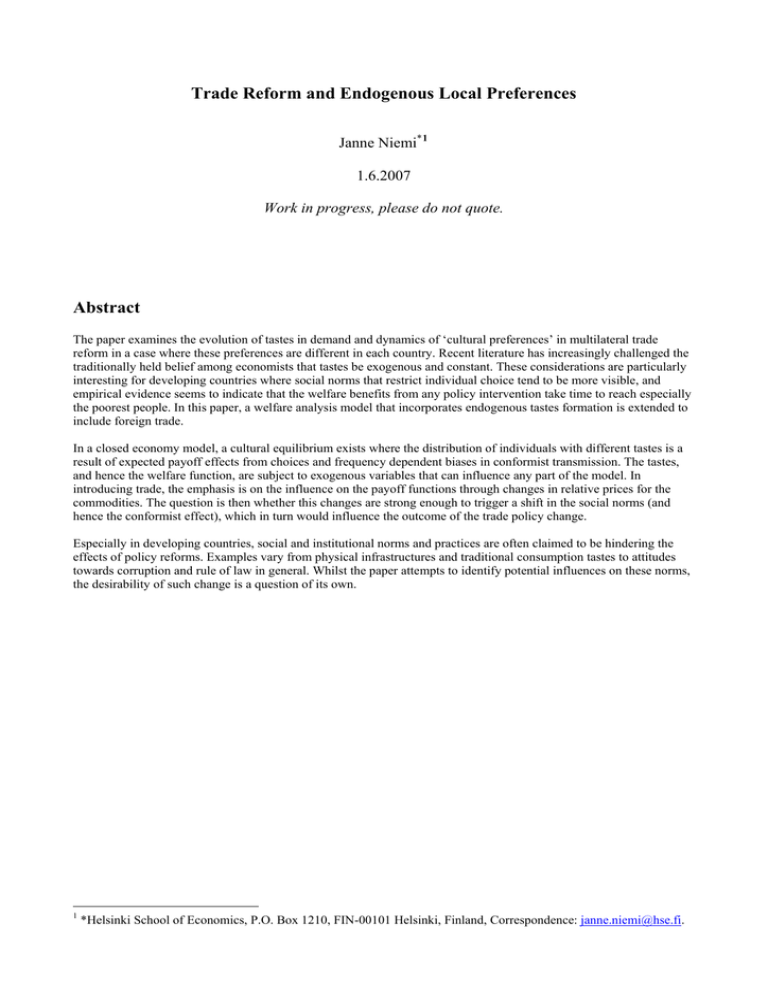
Trade Reform and Endogenous Local Preferences Janne Niemi*1 1.6.2007 Work in progress, please do not quote. Abstract The paper examines the evolution of tastes in demand and dynamics of ‘cultural preferences’ in multilateral trade reform in a case where these preferences are different in each country. Recent literature has increasingly challenged the traditionally held belief among economists that tastes be exogenous and constant. These considerations are particularly interesting for developing countries where social norms that restrict individual choice tend to be more visible, and empirical evidence seems to indicate that the welfare benefits from any policy intervention take time to reach especially the poorest people. In this paper, a welfare analysis model that incorporates endogenous tastes formation is extended to include foreign trade. In a closed economy model, a cultural equilibrium exists where the distribution of individuals with different tastes is a result of expected payoff effects from choices and frequency dependent biases in conformist transmission. The tastes, and hence the welfare function, are subject to exogenous variables that can influence any part of the model. In introducing trade, the emphasis is on the influence on the payoff functions through changes in relative prices for the commodities. The question is then whether this changes are strong enough to trigger a shift in the social norms (and hence the conformist effect), which in turn would influence the outcome of the trade policy change. Especially in developing countries, social and institutional norms and practices are often claimed to be hindering the effects of policy reforms. Examples vary from physical infrastructures and traditional consumption tastes to attitudes towards corruption and rule of law in general. Whilst the paper attempts to identify potential influences on these norms, the desirability of such change is a question of its own. 1 *Helsinki School of Economics, P.O. Box 1210, FIN-00101 Helsinki, Finland, Correspondence: janne.niemi@hse.fi. It is empirically obvious that unlike the standard international trade theory assumes, consumer preferences in different countries are not identical. In this paper, there are two small economies, both of which consume two commodities, rice (xR) and wheat (xW). Both countries produce both commodities, but Home country has a comparative advantage for producing rice and foreign country for producing wheat, and in both countries both rice and wheat are consumed. In home country consumers get higher utility from rice and in foreign country from wheat. Let us assume that in all other respects the two courtiers are similar. Tastes, imperfect substitution and evolution of preferences The underlying explanations for different utility functions in two countries can be found from literature on the role of social norms, culture and institutions in economics. In case of food items, such as rice and wheat, we are dealing with tastes that have been acquired from early childhood, and are unlikely to change fast, if at all – it will probably take several generations for an important change to take place. Moreover, the preferences are influenced not only by individual taste acquisition but also by ‘institutional’ factors. The traditional ways and skills of preparing food, i.e. technology, may be biased in favour of one commodity and limit people’s ability to exploit the other commodity. Governments may also implement protectionist trade policies which favour the use of the commodity that is traditionally produced domestically. In applied partial and general equilibrium models on trade policy, it is standard practice to assume imperfect substitution between domestic and imported goods. This is represented by Armington elasticities (Armington 1969), which is a measure of the degree of substitution between domestic and imported goods. While standard transparent approaches to econometric estimation of these elasticities have been offered for the last 30 years, the estimates are viewed as too small by many trade economists. 2 Further, analysis on what explains the imperfect substitution between home and foreign goods in consumption has been scarce. Already Linder (1961) suggested that elasticities of substitution be higher between goods from countries with similar income levels, as the consumer tastes, and hence goods produced, in those countries are likely to be similar. In an econometric analysis of differences in Armington elasticities between different US industries, Blonigen and Wilson (1999) find some evidence to support the hypothesis that imports from developing countries be less perfect substitutes than imports from other developed countries. However, the results are somewhat ambiguous and the paper does not attempt to analyse the sector differences from country of origin perspective. While examples of economic theory discussing social norms and cultural aspects date back to as early as Veblen’s (1934) Theory of the leisure class, it is not until fairly recently that models have been developed to incorporate these aspects in the standard economic analysis. Some significant early works include Akerlof (1976) on explaining the practice of sharecropping, statistical and effort-based discrimination at work and dynamics of caste system. Specifically on taste formation based on consumer’s own previous consumption as well as interdependence with other consumers’ preferences has been set forth by Pollack (1976 and 1978). The latter is an attempt to combine the effects of taste change in demand analysis and welfare analysis, which have been otherwise studied separately. Bowles (1998) provides a comprehensive review of various approaches to the endogenous preference formation, both in economics and other social sciences, and outlines five categories of market and institutional effects on preferences: (1) Framing and situation construal, (2) Intrinsic and extrinsic motivations, (3) Effects of evolution of norms, (4) Task performance effects, and (5) Effects on the process of cultural transmission. For the questions in this paper, effects (3) and (5) are particularly interesting. 3 Evolution of norms can alter the returns to relationship-specific investments through the influence of economic institutions on the structure of social interactions. While the present example of basic food products may not be the most likely source of social status formation, it is nevertheless plausible that socially constructed beliefs, along with individual tastes, determine the choices of an individual consumer. Markets and other institutions also affect the cultural learning process, partly independently of other norm formation effects. Model of consumer preferences and their evolution Most of the recent research on endogenous preference formation and transformation consider social status. Therefore, they typically model the preferences as inter-generational choices, where for example parents maximise their expected utilities, in addition to their own consumption choices, based on the prediction of their children’s future consumption opportunities or status, e.g. Bowles (1998) and Fershtman and Weiss (1998). The approach here differs from the social status-driven ones in making taste formation dependent only on exposure to the product. While this simplifies the dynamics a great deal, the idea of inter-generational taste formation is still present implicitly, as the children are assumed to inherit their parents preferences by default, and the exposure to the product – or lack thereof – may trigger a change in their consumer type. In the Home country, there are two types of consumers. Type N consumers have ‘normal’ CobbDouglas type of utility function where they get some utility from both goods consumed, whereas Type C consumers have ‘conservative taste’ and they get little or no utility from consumptions of the foreign good. For simplicity, let us assume that the Type C consumer only gets utility from the domestic good consumed. In home country the utility functions are then denoted uN(xNR, xNW) = xNRαxNW1-α (1) 4 uC(xCR) = xCR (2) Thus for a Type N consumer pRxNR/pWxNW = α/(1- α) As the demand functions for each consumer type are not equal, the total demands for each good have to be computed separately. Let us denote with Xi the total consumption of good i, which is a function of the demands by two types of consumers and their shares in the economy. Total demands for each good in period t can be derived as follows: Obviously, for Type N consumer xNR= αw/apW,and xNW=(1-α)w/pW (3) And for Type C consumer xCR=w/apW, xCW=0 (4) In addition to the prices, the total consumption of each good depends on the numbers of different types of consumers. Denoting the share of Type N consumers at period t with bt ∈ ]0,1[ the total consumptions of each commodity can be expressed: XRt = [btα + (1-bt)]w/pR = [1 – bt(1- α) ]w/pR (5) XWt = bt(1-α)w/pW (6) Above, w is the wage that is initially assumed to be equal to income per capita y, which is equal to all consumers in each country, a proportion of Y. As the number of consumers is normalised to 1, w is equal to Yt = pRXRt + pWXWt. In further scenarios, where public policy interventions, such as income taxes, are introduced, w can become different from Y. Dividing (6) by (5), we get the ration of total consumptions of good W to good R: XWt/XRt = [bt(1- α)/(1 – bt(1- α))] pR/pW (7) 5 From equations (5) and (6) we can also directly see a potential explanation for ‘underestimation’ of the Armington elasticities. Thinking of wheat as a foreign substitute for rice, it would, in a standard economy of just one type consumers, obviously have price elasticity 1-α, which in now becomes bt(1-α). As b < 1, the elasticity is indeed lower. Numbers of each type of consumer within a country at a given period are a function of the numbers and the total consumption of each good in the previous period. This represents a ‘learning’ effect or development of tastes, as Type C consumers have a chance with probability θ to transform into Type N consumers through exposure to the foreign good. bt+1(bt,XWt) = bt+ θ(XWt)(1-bt) (8) Δb = θ(XWt)(1-bt) (9) In other words, a share θ of Type C consumers transforms to Type N, and θ is an increasing function of XW. This can be interpreted as the generation t+1 acquiring initially the tastes of the generation t, and during childhood being subject to eventual type change represented by θ, so that bt+1 refers to the share of Type C consumers when the generation has reached adult age. The increasing b in time, in a ‘normal’ case, is also consistent with the idea that Armington elasticises be considerably higher in long run than in the short run. It could be argued that the type transformation probability should rather be based directly on the share of type N consumers in the population than the consumption of good W, as that would reflect the idea of ‘change agents’ who would ‘convert’ the conservative consumers to new taste. However, looking at such basic commodities as food, the total consumption seems more plausible, as the idea is that the tastes develop from actual exposure, not from awareness. Consider an economy where there is initially a high share of type N consumers, but the price for wheat pW is very high. Type N consumers would then consume wheat, but only small quantities, for 6 example once a week on Sunday dinner, and the probability that a child of type C consumer would come across with wheat products is rather low. In inverse case, with low share of type N but cheap wheat, a single wheat user may be using it in large quantities, and for example possibly frequently offering it to type C dinner guests. Of course, an additional element not considered in this paper, in case of very expensive wheat, would be it gaining a prestige value and becoming attractive as a sign of social status. No taste evolution occurs among generation that has reached adulthood. At very low values of XW the share of Type C consumers may increase, as (for example) part of the children of Type N consumers does not get the exposure to good W, hence θ would be negative. In the special case where there are initially no consumers of type N, i.e. b0 = 0 and XW0 = 0, the taste evolution only depends on θ, as both (8) and (9) become Δb = b1(0) = θ(0). (10) This implies that there can be a ‘natural tendency’, or ‘curiosity’, among consumers to try new products despite not being exposed to them personally. However, as b cannot be negative, we have to restrict θ so that θ(XW) ≥ –1 (this is sufficient since 0 < 1-b < 1). For any b>0, it would be possible have function θ so that there is a ‘natural aversion’ or ‘change resistance’, and thus θ(XW)<0. Respectively, if there are only consumers of type N, i.e. b0 = 1, there is no evolution of tastes irrespective of the consumption, since b1(1) = b0(1) = 1 and Δb =0 (11) In other words, there is no chance of children of type N consumers becoming type C, unless there is at least a small fraction of type C in the population. While the model may be considered too 7 restrictive with this respect, the restriction is not relevant for the question of evolution of tastes of type C consumers when Good W becomes more attractive. Let us consider a case where the θ is a linear function of X2 of form: θ(XWt) = rXWt -s (12) Then, obviously, the share of Type N consumers is decreasing, constant or increasing when X2t < s/r, XWt = s/r, or XWt > s/r, and Δb = bt+1 - bt = (rXWt -s)(1-bt) (13) For the non-negativity condition of b rXWt -s ≥ –1 (.) XWt ≥ (s – 1)/r (14) Plugging in (6) b ≥ (s – 1) pW/ rw(1-α) (15) The right hand side is by parameter definitions negative, hence the non-negativity condition holds for any value of b. The change is total demand of good W from period t to t+1 can now be expressed, using (6) in (13), and denoting A= (1-α)/pW: (1/wA)XWt+1 – (1/wA)XWt = (rXWt -s)[1-(1/wA)XWt] (16) Multiplying this by A and rearranging yields: XWt+1 = –swA + (rwA+s+1)XWt – rXWt2 (17) ΔXW = XWt+1 – XWt = –swA + (rwA+s)XWt – rXWt2 (18) and 8 In order to present the total demand in the following period as a function of present period prices and share of type N consumers, let us plug (6) again back to (17): XWt+1 = –swA + (rwA+s+1)bt/wA – r(bt/wA)2 = –swA + (r+(s+1)/wA)bt – r(bt/wA)2 (19) And writing out A: = –sw(1-α)/pW + (r+(s+1)/ w(1-α)/pW)bt – r(bt/ w(1-α)/pW)2 = –sw(1-α)/pW + (r+ pW(s+1)/ w(1-α))bt – r(pWbt/ w(1-α))2 (19a) The impact of relative price change on the consumption on the following period can then be presented: δXWt+1/δpW = sw(1-α)/pW2 + bt(s+1)/ w(1-α) – 2rpWbt/ w(1-α) (20) The consumption of wheat will increase, if: δXWt+1/δpW > 0 (21) sw(1-α)/pW2 + bt(s+1)/ w(1-α) – 2rpWbt/ w(1-α) > 0 s(w(1-α)/pW)2 + bt(s+1) – 2rbt pW > 0 p3 – [(s+1)/2r]p2 – sw2(1-α)2/ 2rbt < 0 (22) In the steady state where XWt = s/r p3 – ½[XWt +1/r]p2 – w2(1-α)2 XWt / 2bt < 0 (23) Let us normalise w=1 and study a case where α=0.5 p3 – ½[XWt +1/r]p2 –XWt / 4bt < 0 2p2(2p – 1/r)/(1/bt + 2) < XWt (24) Hence, if the left-hand side of the inequality (24) is equal to the total consumption of good W at period t, the price change will have no effect on the consumption at period t+1. Plugging this to (13): 9 Δb = (2p2(2pr – 1)/(1/bt + 2) -s)(1-bt) (25) Δb > 0 ⇒ (2p2(2pr – 1) > s(1/bt + 2) (26) Inequality 18 is the condition for share of Type N consumers to increase. Income and taxes The above analysis becomes a great deal simpler, if we make the usual assumption that the consumers are the producers and there are no taxes in the economy, i.e. the income Yt = pRXRt + pWXWt, which, in the normalised form used above, equals the average income w. Using 6a we have: w = XWt[(1/b(1- α ) – 1]pW + pWXWt = pWXWt/b(1- α ) (27) We can now write 11a as (bt/ XWt)XWt+1 – (bt/ XWt)XWt = (rXWt -s)[1-(bt/ XWt)XWt] (28) (bt/ XWt)XWt+1 – bt = (rXWt -s)(1-bt) XWt+1 – XWt = (rXWt -s)(1-bt)XWt /bt =(bt+1 - bt) XWt /bt (30) The last form shows that ΔXW equals Δb multiplied by the average consumption of XW by type N consumers. Now, the effect on future demand of a consumption shock at period t becomes δΔXW//δXW = (2rXWt-s)(1/bt–1) (31) Introducing trade For analysing the impact of trade, let us consider a simple, basic Ricardian model. A single production factor is used for both rice and wheat, and a different amount of the production factor is required for each community in each country. This reflects the idea that the home country is relatively more ‘apt’ for producing rice than foreign country. In reality, there would be several factors explaining the difference, most important being the suitability of farm land, but the composite effect of them all is considered here. 10 In foreign country similarly to Home: u*N(x1, x2) = x1α*x21-α* *C u (x2) = x2 (30) (31) However, for simplicity, let us assume that in foreign, b*=1 and α*= α, hence: u*N(x1, x2) = x1αx21-α (32) X1* = (1-α)w*/p1 (33) X2* = αw*/p2 (34) Normalise for total production factor in both countries: L = 1. Denoting the rations of the production cost (amount of production factor required for producing a single unit of good) of good R (rice) to good W (wheat) with p and p*; p < p*. p1/p2 = p (35) p1*/p2*=p* (36) Plug this into (5)-(6) and(22)-(23): X1 = [1 – bt(1- α)]wp/p2 (37) X2 = bt(1-α)w/p2 (38) X1* = (1-α)w*p*/p2* (39) X2* = α(1-bt)]w*/p2* (40) Thus the total productions Y = W = p1X1+p2X2 (41) w/p2 = pX1 + X2 (42) 11 (43) (1-p)bt(1-α) =1 - p (44) bt(1-α) = 1 (45) Y* = [1 – bt*(1-α*)(1-p*)]w*/p2* (46) x2 [1 – bt(1- α)]wp + bt(1-α)w = w x1 As the Type C consumer’s optimum would always be in the corner point of the budget constraint, it is clear that an improvement in Type N consumer’s utility in some cases corresponds to a decrease in Type C utility. Interest is to find the cases where the loss can be compensated. 12 5 A p4 B C B' A' p3 p X2 2 1 θ 0 -s 1 5 9 13 17 21 25 29 33 37 41 45 49 53 57 61 65 69 73 77 81 85 89 93 97 101 -1 x, b, ... Figure illustrates the outcomes of introducing trades under different starting conditions of the Home country economy. The total demand curves illustrate the consumption of good W consumer and p is the autarky price ratio. If the Home economy is initially at A, the share of Type N consumers (and hence the consumption of good W in following periods) is decreasing at relatively small values of s, but trade triggers a large increase in good W consumption to A', and may then change the value of θ to positive. If the θ remains negative after the initial shift, the dynamic effect is ambiguous, as a sufficient increase in X2 may still result in further shift at following periods. If the Home economy is initially at B and following trade shifts to B', the value of θ after the initial shock is crucial, since a further shift of X2 curve does not result in change of demand, as no more good W is available at the lower price. Extensions and further considerations 13 The model presented in this paper makes simplifying assumptions about the functional forms, and further study is required to see under which conditions the results hold with a more general setting. It has also been shown that results generated with a simple two-country model do not necessarily hold generally, so extension of the model to a multi-country one may be required. Multilateral trade reform analysed can be further extended to the case where national policy preferences differ from individual preferences, and the national policy preferences are also different in each country. These differences can be modelled by assuming there are national merit goods, which results in governments applying a form of correction to consumers’ preferences. The government intervention in favour of merit goods can be justified by distributional arguments or market failure arguments, but this paper assumes that these arguments are based on social norms and cultural values prevalent among the individuals of the country, and hence the merit goods policies are subject to change should there be a sufficient shift in these norms and values. From the point of view of a social planner, good W can be viewed as a merit good. Besley (1988) provides a simple model of merit goods, i.e. goods that have higher value for the social planner than the utility perceived by the consumer. Haaparanta (2006) shows that in general, it is always possible to design a multi-lateral tariff reform so that it is Pareto-improving even in presence of national merit goods. In the model presented in this paper, with endogenously determined preferences, social planner can factor in the increased utility experienced by next generation and therefore favour the consumption of good W. However, if a local equilibrium exists where increase in demand of (foreign) good W decreases the overall welfare due to an income effect greater than the price effect, thus making it a demerit good, then a social planner may be tempted for a protectionist policy that leads to equilibrium with a lower total welfare. Whether this type of equilibrium would be in steady state requires further research. 14 Another extension could refer to prestige value of the other good, using a model that incorporates a social status in the consumer’s choice problem. 15 References Akerlof, G. (1976). The economics of caste and of the rat race and other woeful tales. Quarterly Journal of Economics, Vol. , pp. 599–617. Armington, P.S. (1969). A theory of demand for products distinguished by place of production. IMF Staff Papers 16, pp. 159–176. Baldwin, R.E. (1992). Measurable dynamic gains from trade. Journal of Political Economy, Vol. 100:1, pp. 162–174. Basu, K. (1989). A theory of association: social status, prices and markets. Oxford Economic Papers 41, pp. 653–671. Basu, K. (2000). Social norms, culture and Beliefs. In: Basu K: Prelude to political economy – a study of the social and political foundations of economics. Oxford New York, Oxford University Press. Besley, T. (1988). A Simple Model for Merit Good Arguments. Journal of Public Economics, Vol 35, pp. 371–383. Bloningen, B.A. and Wilson W.W. (1999). Explaining Armington: what determines substitutability between home and foreign goods? Canadian Jouranl of Economics, Vol 32:1, pp. 1-21. Bowles, S. (1998). Endogenous preferences: the cultural consequences of markets and other economic institutions. Journal of Economic Literarture, Vol. 36:1, pp. 75–111. Fershtman, C. and Y. Weiss (1998) Social Rewards, Externalities and Stable Preferences. Journal of Public Economics, Vol 70, 53-73. Haaparanta P. (2006). Nationalism, Merit Goods and Multilateral Trade Reform. HECER Working Papers Pollak, R.A. (1978). Changes in consumer preferences – endogenous tastes in demand and welfare analysis. The American Economic Review, Vol 68:2, pp. 374–379. Rodrik, D. (2001) The developing countries hazardous obsession with global integration, mimeo, published as revised in Foreign Policy, available at http://ksghome.harvard.edu/~.drodrik.academic.ksg/papers.html Rodrik, D. and Rodriguez F. (2000) Trade Policy and Economic Growth; A Sceptics guide to the Cross-National Evidence, available at http://ksghome.harvard.edu/~.drodrik.academic.ksg/papers.html Sen, A.K. (1970). Collective choice and social welfare (North-Holland, Amsterdam). 16
